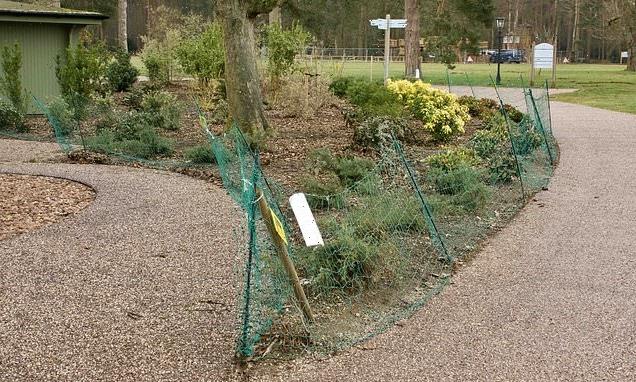The Queen’s Sandringham estate may scrap its use of electric fences to protect shrubs in the royal parks after warnings they can kill hedgehogs
- Staff at the Norfolk estate recently put up a 75 yard stretch of electrified netting to stop newly-planted shrubs being nibbled by rabbits
- The British Hedgehog Preservation Society contacted the estate to ask them to remove it
- The fence was later taken down by estate staff although Royal officials said that it had only been installed as a temporary measure
- A spokesman said: ‘The Estate had a constructive conversation with the British Hedgehog Preservation Society on any use of temporary fencing in the future.’
The Queen’s Sandringham estate is reviewing its use of electric fencing after being told that it puts the lives of hedgehogs at risk.
A 75 yard stretch of electrified netting was recently erected to stop newly planted shrubs being nibbled by rabbits and deer beside the royal estate’s visitor centre.
The British Hedgehog Preservation Society contacted estate staff and pleaded for it to be removed after hearing about it.
Electric fences are said to be potentially fatal for hedgehogs because they curl up rather than move away if they come into contact with one, so they end up getting repeated shocks.
The fencing was later taken down by estate staff although Royal officials said that it had only been installed as a temporary measure and had been due to be removed.
Fay Vass, the chief executive of the British Hedgehog Preservation Society said: ‘Electric fences can certainly kill hedgehogs so this was of concern.
The Queen’s Sandringham estate is reviewing its use of electric fencing after being told that it puts the lives of hedgehogs at risk
A 75 yard stretch of electrified netting was recently erected to stop newly planted shrubs being nibbled by rabbits and deer beside the royal estate’s visitor centre
A Sandringham spokesman said: ‘The Estate had a constructive conversation with the British Hedgehog Preservation Society on any use of temporary fencing in the future.’
‘When they get a shock from the fence, their instinct is to curl up. This entangles them further and they receive multiple shocks.
‘We have had reports of hedgehogs being found dead like this. Hedgehogs are in decline and need all the help they can get. We have lost a third in urban areas and half in rural areas just since the turn of the century.
‘Every hazard they face that can be removed should be so as to improve their chances.
‘We contacted the estate after hearing about the fencing and they replied very promptly and seemed hedgehog-friendly. They took the point about the fences and we are very happy that they have now been removed.’
A Sandringham Estate spokesperson said: ‘The temporary fencing has been removed as planned ahead of the partial re-opening of visitor facilities on 12th April.
‘The Estate had a constructive conversation with the British Hedgehog Preservation Society on any use of temporary fencing in the future.’
The heavy duty green electrified netting used at Sandringham is sold by UK firm Rappa for £113 for 50m sections which can be easily joined together, and is described on the firm’s website as being designed to keep rabbits away from ‘precious crops’.
It was erected as part of landscaping work to compliment improvements to the estate’s restaurant and shop and better car parking for its 500,000 visitors a year.
Signs on the netting which stretched around a large plant bed warned of the danger of people with heart conditions getting a small shock.
The signs said: ‘Dear Visitors, To protect the planting in this area during winter months and to deter animals from causing further damage, we have installed an electric fence.
‘Visitors with pacemakers should be especially cautious of touching the fencing when active. The electric fence will be active from 4pm until 8am and is designed to protect new planting.’
The fencing was later taken down by estate staff although Royal officials said that it had only been installed as a temporary measure and had been due to be removed
While the 20,000 acre Sandringham estate remains the private property of the Queen, the responsibility for its running passed from Prince Philip to Prince Charles in 2018.
Charles who is well known as a champion of the natural environment is behind plans to turn over the estate to organic farming.
Britain had an estimated 35million hedgehogs in the 1950s, but the population is now believed to be less than a million.
Hedgehog numbers are said to have been hit by the increased use of pesticides killing invertebrates which they eat, the ploughing over of pastures and excessive trimming of hedgerows in rural areas.
The population has been hit in towns and cities by house building, busy roads, gardens lost to car parking and trendy decking.
The British Hedgehog Preservation Society joined forces ten-years-ago with the People’s Trust for Endangered Species to launch the Hedgehog Street campaign to try and get people to manage their gardens and green spaces with hedgehogs in mind.
The campaign has produced a guidance booklet for land managers, suggesting how they might improve practices to benefit hedgehogs.
Source: Read Full Article




